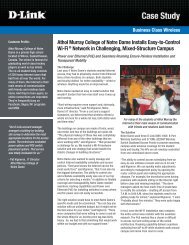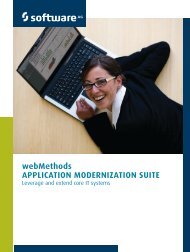Firewall Security for SMB Networks
D-Link firewall smb white paper.pdf - FTP
D-Link firewall smb white paper.pdf - FTP
- No tags were found...
Create successful ePaper yourself
Turn your PDF publications into a flip-book with our unique Google optimized e-Paper software.
<strong>Firewall</strong> <strong>Security</strong> <strong>for</strong> <strong>SMB</strong> <strong>Networks</strong>Application FilteringApplication filtering takes SPI a step further. While SPI determineswhat type of protocol is being sent over each port, application-levelfilters examine what the protocol is being used <strong>for</strong>. The applicationfilter can tell the difference between peer-to-peer file sharing andstandard HTTP traffic, <strong>for</strong> example. A SPI firewall treats all HTTPtraffic equally and cannot make this distinction.Application filtering firewalls typically maintain multiple applicationproxies on a single firewall. Since these proxies sit between theclient and server, the two end points never communicate directly.As a result, suspicious data can be dropped without incident. Also,since application filters are application-aware, they can handlecomplex teleconferencing and VoIP protocols like H.323.Typical <strong>Firewall</strong> FunctionsDMZ - (DeMilitarized Zone)<strong>Firewall</strong>s establish a middle ground between trusted internalnetworks and untrusted external networks such as the Internet.Companies usually place their Web, email and authentication/policyservers in the DMZ. The area acts as a subnet between firewalls andsystems. DMZs are also referred to as “perimeter networks.”Port ForwardingThis is the function that allows parties outside the corporatenetwork to contact a user inside. A port is opened on the firewall toallow <strong>for</strong> a specific type of communication. A port opened <strong>for</strong> VoIP,<strong>for</strong> example, creates an easy two-way channel <strong>for</strong> calls initiated bysomeone inside or outside the network.Port TriggeringThis is the function that opens specific ports based on specifictrigger conditions. For example, predetermined ports might sendinbound traffic to specific incoming ports when a client on the localnetwork makes an outgoing connection to a predetermined porton a server. <strong>Security</strong> is enhanced because incoming ports are notopen all the time. They are opened only when a program is activelyusing the trigger port. This is useful on NAT-enabled routers thatprovide services that require a static host (or unchanged networkaddress). NAT is discussed in more detail below. This function isdisadvantageous in that only one client at a time is allowed to use aparticular service on a particular port.Virtual Private Network (VPN)Most firewalls support VPN functionality, which encrypts data intransit to prevent theft, misuse or unauthorized access.Extended or Advanced Network<strong>Security</strong> FeaturesNetwork Address Translation (NAT)Many firewalls now feature Network Address Translation (NAT) toNovember, 2008hide addresses of protected resources from malicious intervention.This functionality establishes a “private address range,” which hidesthe true address of protected hosts. The feature is technically notconsidered a “firewall,” however it’s now quite common. NAT wasoriginally developed to address the limited number of IPv4 routableaddresses and reduce the costs associated with obtaining publicaddresses <strong>for</strong> every computer in a network.NAT TraversalIn certain situations some effects of the NAT function can beundesirable, however. NATs often block certain types of traffic thatusers and businesses want to utilize. For example, VoIP networks,P2P file sharing, and online services <strong>for</strong> video game consoles (likethe Xbox 360’s Xbox Live or PS3’s PlayStation Network) requireclients to act like servers. Since requests cannot be correlated tothe proper internal host, this poses a problem <strong>for</strong> users behind NATdevices. The NAT device has no way of determining which internalhost incoming packets should be routed to.NAT traversal is the solution. This is the general term <strong>for</strong> varioustechniques that establish and maintain network connections thattraverse NAT gateways. The problem is that most NAT techniquesbypass enterprise security policies and break end-to-endtransparency. Ideally, NAT traversal would cooperate with NAT andfirewalls, allowing traversal while still en<strong>for</strong>cing enterprise securitypolicies. Two IETF standards are addressing this issue - Realm-Specific IP (RSIP) and Middlebox Communications (MIDCOM).Other Technologies Associated with Network<strong>Security</strong> and <strong>Firewall</strong>sUnified Threat Management (UTM)UTM describes a category of security devices that integrate multiplesecurity features into a single appliance. They typically combinefirewall, gateway, anti-virus, anti-malware, anti-spam, and intrusiondetection and prevention capabilities into a single plat<strong>for</strong>m.Intrusion Detection System/Intrusion Prevention System (IDS/IPS)IPSs provide another layer of internal network security by detectingand blocking malicious traffic and suspicious traffic patterns.<strong>Firewall</strong>s are commonly offered in combination with IPSs.Access Control List (ACL)An ACL is basically a table or data file that determines whether auser is granted access to a specific computer, network or applicationresource. It also contains in<strong>for</strong>mation about what kinds of rights andprivileges the user has with respect to the resource (e.g. read, write,execute, delete). An ACL <strong>for</strong> a network is similar to a firewall in thatthe data table specifies lists of ports and services available on aspecific host. By assisting a switch in deciding whether to <strong>for</strong>wardor filter packets, the list controls access to and from the network.3






